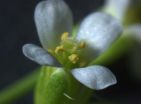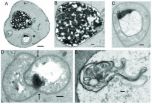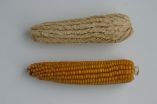(Press-News.org) Northridge, Calif. (April 24, 2012) – A dose of 10 milligrams (mg) daily of S-equol delivered via a newly developed fermented soy germ-based nutritional supplement is as effective as a standard dose of soy isoflavones at reducing hot flash frequency significantly and is even more effective for relieving muscle and joint pain, according to a peer-reviewed study in US postmenopausal women published in the June Journal of Women's Health, available now as a Fast Track article online ahead of print.
"This study provides evidence that daily doses of the supplement S-equol, a metabolite of the soy isoflavone daidzein, reduced hot flash frequency and relieved muscle and joint pain in U.S. postmenopausal women. These findings confirm earlier studies in Japanese women documenting S-equol's ability to relieve menopausal symptoms," said Belinda H. Jenks, Ph.D., coauthor of the study and director of Scientific Affairs & Nutrition Education at Pharmavite LLC. Development and ongoing research of a supplement containing S-equol is conducted by the Saga Nutraceuticals Research Institute of Otsuka Pharmaceutical Co., Ltd. Pharmavite LLC, the makers of Nature Made® vitamins and minerals, is a subsidiary of Otsuka, which supported the study.
S-equol Supplement Reduces Menopausal Hot Flashes, Muscle and Joint Pain in U.S. Women
Daily doses of the supplement containing 10, 20 or 40 mg of S-equol each reduced the frequency of moderate to severe hot flashes similarly to a 50 mg dose of a soy isoflavone supplement in a double-blinded randomized study involving 102 US postmenopausal women aged 45 to 65 who experienced more than 35 hot flashes weekly when they enrolled. The investigators used a standardized soy isoflavone supplement for comparison in the study because of the scientific consensus that extracts or concentrated soy isoflavones support relief of hot flashes in menopausal women, based on placebo-controlled studies.
The investigators observed, after eight weeks of treatment, significant reductions occurred from the study start in the women's average daily hot flashes, the study's primary endpoint. These reductions were comparable for all three S-equol treatment groups, 10, 20 or 40 mg, which ranged from decreases of 3.09 to 3.66 hot flashes daily, to that of the soy isoflavone group, which averaged decreases of 2.92. The average number of daily hot flashes in all of the participants at the study start was 10.0 ± 4.03.
Muscle and joint pain improved significantly for both the 10 and 20 mg doses of S-equol compared with the soy isoflavones (p=0.003 and p=0.005, respectively), based on scores from the Greene Climacteric Scale (GCS), which measures 21 symptoms using 0 to 3 scale, where 0 was 'not at all,' 1 was 'a little,' 2 was 'quite a bit' and 3 was 'extremely,' to produce scores.
"These U.S. data expand on the previous studies in Japanese women and further document that a minimum daily 10 mg dose of S-equol would likely help women by both reducing the frequency of their hot flashes as well as decreasing their muscle and joint pain associated with menopause," said Jenks.
Further, for women who had more than eight hot flashes daily at the study start, both 20 and 40 mg S-equol were significantly better than the soy isoflavones in reducing hot flash frequency (p=0.045 and p=0.001, respectively), while the 10 mg S-equol dose had a strong positive trend (p=0.063), according to a sub-group analysis. This finding suggests that the S-equol supplement might be more useful for the women who have a higher frequency of hot flashes, Jenks said.
Also, more women in the 10, 20 and 40 mg S-equol groups achieved a reduction of 50 percent or more in their hot flash frequency by the study end than in the soy isoflavone group: respectively, 25.0, 27.3, 42.9 (P=0.056) and 16.0 percent.
No significant differences occurred between any of the S-equol groups and the soy isoflavone group for two secondary endpoints: the hot flash severity and the psychological (anxiety, depression), somatic (physical), vasomotor GCS subscales. Throughout the eight-week intervention, the women maintained a daily diary to record the frequency and severity of their hot flashes, rating them as mild (sensation of heat without sweating), moderate (sensation of heat with sweating, able to continue activity) or severe (sensation of heat with sweating, causing cessation of activity).
No trends or clinically meaningful changes were identified in the women's laboratory blood or urine tests, hormone levels, electrocardiographs, physical examinations or vital signs. The trial investigators noted treatment-emergent adverse effects in participants of all the treatment groups. Such effects occurring in more than 10 percent of any S-equol group included abdominal distention (eight women) and endometrial hypertrophy (three women), the thickening of the lining of the uterus. The endometrial hypertrophy was identified by transvaginal ultrasounds and was assessed by the Medical Monitor; any changes observed were not considered to be clinically significant.
Of note, Jenks explained, endometrial hypertrophy developed in three women in the 10 mg S-equol group but only one and none in the 20 mg and 40 mg S-equol groups, respectively, which suggest that S-equol does not affect endometrial hypertrophy. Moreover, gastrointestinal disorders in the seven women in both 10 mg and 20 mg S-equol groups as well as the one in the 40 mg S-equol and two in the isoflavone groups, may have resulted from the naturally occurring dietary fiber in the fermented soy germ-based nutritional supplement containing S-equol and from the lactose in the placebo tablets used to match the total number of tablets in each group.
At enrollment, the women had not experienced a menstrual period in the previous 12 months and their levels of follicle stimulating hormone (FSH) were 40 or more milli international units/milliliter, a marker of menopause. The women were in good health. Investigators did not enroll anyone with a history of breast, ovarian or uterine cancer or endometrial hyperplasia, with a body mass index of 33 kg/m2 or more or who had used hormone replacement therapy within 90 days of the study or soy, phytoestrogens or certain other supplements within 30 days of the study, as well as fitting certain other exclusion criteria.
Investigators randomized the 102 women into four groups to consume twice daily either the isoflavone (26 women) or one of the three doses of the S-equol supplement (24 in the 10 mg, 27 in the 20 mg and 25 in the 40 mg groups). The lowest dose of S-equol used, 10 mg, was based on preliminary studies that investigated the relationship between S-equol and menopausal symptoms including hot flashes in Japanese women, while the higher doses were used to reflect the larger body mass in Western women and to establish a dose response. The S-equol supplement tablets each contained 5.0 mg S-equol, 1.0 mg daidzein, 1.1 mg genistein, and 2.5 mg glycitein. The soy isoflavone tablets contained 24 mg daidzein, 22 mg genistein, and 2.0 mg glycitein as aglycone equivalent. The placebo tablets contained lactose.
The women had diets controlled for soy foods, isoflavones and lignans, compounds found in certain plants that are known as phytoestrogens because of their estrogen-like properties. The study included a seven-day period before the treatment weeks to allow for elimination of any women who responded to a placebo. Women also were tested to determine their ability to produce S-equol after eating soy. The study included 72 percent equol nonproducers and 28 percent equol producers, which represents the previously reported US equol producer ratio. The investigators randomized the equol producers equally into each of the study's treatment groups.
No previous studies have reported the effects of either soy isoflavones or S-equol on muscle and joint pain. Recent studies conducted with Japanese postmenopausal women documented that measures of neck or shoulder muscle stiffness improved with daily consumption of 10 mg S-equol supplements, compared to a placebo, as well as reduced the frequency of hot flashes. While muscle stiffness and muscle pain can result from impaired local blood flow and both soy isoflavones and S-equol are thought to affect blood flow, this new study suggests that S-equol may potentially be more effective than isoflavones, Jenks explained.
About S-equol
S-equol [7-hydroxy-3-(4'-hydroxyphenyl)-chroman] is a compound resulting -- when certain bacteria are present in the digestive tract -- from the natural metabolism, or conversion, of daidzein, an isoflavone found in whole soybeans. Not everyone can produce S-equol after soy consumption, as the production depends on the types of bacteria present in the large intestine and may be influenced by the amount of soy consumed. About 50 percent of Asians and 20 to 30 percent of North Americans and Europeans, who in general consume less soy than Asians, have the ability to produce S-equol. Evidence from observational studies is emerging that suggests that women have milder menopausal symptoms in those who are S-equol producers compared to nonproducers.
S-equol binds to the same estrogen receptors as naturally estrogen, with a strong affinity to the estrogen receptor beta. On binding to these receptors, S-equol mimics some, but not all, activities of estrogen. Because of these actions at the receptor, it has been proposed that S-equol may alleviate some of the symptoms caused by diminished estrogen production during menopause.
The safety of the supplement containing S-equol previously was confirmed by standard animal testing, including a study documenting that S-equol itself, as well as the supplement containing S-equol, did not increase or stimulate the growth of breast cancer cells. Studies involving postmenopausal women who consumed the supplement containing S-equol have not observed any safety problems, including analysis of breast and reproductive tissues and of hormone levels. More information about S-equol and the supplement is at http://www.naturalequol.com.
How the S-equol Supplement is Made
The supplement is the product of fermentation of whole soy germ by the bacterial strain Lactococcus 20-92 using a patented and proprietary process by the Otsuka Pharmaceutical Co., Ltd. The process results in the conversion of the daidzein to S-equol. The S-equol ingredient is created under current Good Manufacturing Practices. Following fermentation, the bacteria undergo heat denaturation and are deactivated. The process is designed to produce a S-equol rich product, or nutraceutical ingredient. The ingredient has self-affirmed GRAS (Generally Recognized As Safe) status.
###
The study data were presented in a late-breaking session at presentation at the North American Menopause Society annual meeting in October 2010.
Journal of Women's Health, Online Ahead of Print: March 12, 2012 doi:10.1089
A Pilot Study on The Effects of S-equol Compared to Soy Isoflavones on Menopausal Hot Flash Frequency and Other Menopausal Symptoms
Belinda H. Jenks, Ph.D., and Soh Iwashita, Ph.D., of Pharmavite LLC; Yasushi Nakagawa, M.S., Karen Ragland, M.S., Jennifer Lee, Ph.D., and William H. Carson, M.D., of Otsuka Pharmaceutical Development & Commercialization, Inc.; and Tomomi Ueno, M.S., and Shigeto Uchiyama, M.S., of Saga Nutraceuticals Research Institute, Otsuka Pharmaceutical Co., Ltd.
About Pharmavite LLC: For 40 years, Pharmavite has earned and maintained the trust of healthcare professionals, consumers, and retailers by manufacturing high-quality vitamins, minerals, herbs and other dietary supplements that are safe, effective and science-based. Nature Made® is the number one selling dietary supplement brand in the food, drug, club and mass channels. The dietary supplement industry is regulated by the U.S. Food and Drug Administration and the Federal Trade Commission, as well as by government agencies in each of the 50 states.
About Otsuka Pharmaceutical Co., Ltd.: Founded in 1964, Otsuka Pharmaceutical Co., Ltd. is a global healthcare company with the corporate philosophy: 'Otsuka-people creating new products for better health worldwide.' Otsuka researches, develops, manufactures and markets innovative and original products, with a focus on pharmaceutical products for the treatment of diseases and consumer products for the maintenance of everyday health. Otsuka is committed to being a corporation that creates global value, adhering to the high ethical standards required of a company involved in human health and life, maintaining a dynamic corporate culture, and working in harmony with local communities and the natural environment. Otsuka Pharmaceutical Co., Ltd. is a wholly owned subsidiary of Otsuka Holdings Co., Ltd., the holding company for the Otsuka Group. The Otsuka Group has business operations in 23 countries and regions around the world, with consolidated sales of 1,090.2 billion Yen for fiscal year 2010. Visit Otsuka Pharmaceutical Co., Ltd. at http://www.otsuka.co.jp/en/
Soy-based S-equol supplement reduces hot flash frequency, muscle & joint pain in US women
2012-04-25
ELSE PRESS RELEASES FROM THIS DATE:
Molecule movements that make us think
2012-04-25
VIDEO:
A research group at Linköping University has built five different molecular models of the voltage sensor in an ion channel, which together can explain all the experimental data. The five...
Click here for more information.
Every thought, every movement, every heartbeat is controlled by lightning-quick electrical impulses in the brain, the muscles, and the heart. But too much electrical excitability in the membranes of the cells can cause things like epilepsy and cardiac ...
PNAS: Precise molecular surgery in the plant genome
2012-04-25
This press release is available in German.
The new method is based on the natural repair mechanism of plants. So-called homologous recombination repairs the genome when the genome strands in the cell break. "Using an appropriate enzyme, i.e. molecular scissors, we first make a cut at the right point in the genome and then supply the necessary patch to repair this cut," says Friedrich Fauser from Karlsruhe Institute of Technology, who is the first author of the PNAS publication. "A part of this patch is the new gene piece we want to install. The rest is done by the ...
The search for a job begins and ends with you
2012-04-25
Staying motivated is always tough, but it certainly gets easier when you start seeing results. That's why keeping your spirits up during a job search can be extremely difficult. Candidates often face repeated rejection and rarely receive any feedback. A new study that focuses on finding work following a job layoff reveals just how important managing negative thoughts and effort over time are while looking for employment.
The research shows that having a more positive, motivational outlook had a beneficial effect on job pursuit, especially at the outset of the search. ...
Family history of liver cancer increases risk of developing the disease
2012-04-25
A family history of liver cancer is reported to increase risk of developing hepatocellular carcinomas (HCC), independent of hepatitis according to findings published in the May issue of Hepatology, a journal of the American Association for the Study of Liver Diseases. The study also shows 70-fold elevated risk of HCC in those with liver cancer in the family and markers for hepatitis B (HBV) or hepatitis C (HCV).
Liver cancer ranks sixth in incidence and the third cause of mortality worldwide. According to the World Health Organization (WHO) liver cancer was responsible ...
Fibrosis and fatty liver disease increase risk of early atherosclerosis
2012-04-25
Italian researchers report that severe fibrosis increases the early atherosclerosis risk in patients with genotype 1 chronic hepatitis C virus (HCV) infection. A second study found that fatty liver disease also increases risk of developing atherosclerosis at an earlier period. Both studies appear in the May issue of Hepatology, a journal published by Wiley-Blackwell on behalf of the American Association for the Study of Liver Diseases.
In the first study, researchers led by Dr. Salvatore Petta from the Di.Bi.M.I.S. University of Palermo in Italy evaluated 174 patients ...
Bile – not acid – is bad guy in triggering precancerous condition associated with reflux disease
2012-04-25
For many people with gastroesophageal reflux disease or GERD, acid reflux drugs are the answer to their woes, curbing the chronic heartburn and regurgitation of food or sour liquid characteristic of the disorder. But when it comes to Barrett's esophagus, a condition commonly found in people with GERD, acid control may be less important than beating back another bodily fluid – bile.
A new study published in the Annals of Surgery shows that bile – a digestive fluid that leaks backwards from the stomach into the esophagus along with acid in patients with GERD – plays a ...
Improving on the amazing: Ames Laboratory scientists seek new conductors for metamaterials
2012-04-25
AMES, Iowa -- Scientists at the U.S. Department of Energy's Ames Laboratory have designed a method to evaluate different conductors for use in metamaterial structures, which are engineered to exhibit properties not possible in natural materials. The work was reported this month in Nature Photonics.
Cloaking devices that hide planes from RADAR, microscopes that can see inside a single cell, and miniature antennae that measure only a few millimeters all sound like parts of a science fiction movie. But, within the span of the decade since they began their work, Ames Laboratory ...
Binge eating may lead to addiction-like behaviors
2012-04-25
HERSHEY, Pa. -- A history of binge eating -- consuming large amounts of food in a short period of time -- may make an individual more likely to show other addiction-like behaviors, including substance abuse, according to Penn State College of Medicine researchers. In the short term, this finding may shed light on the factors that promote substance abuse, addiction, and relapse. In the long term, may help clinicians treat individuals suffering from this devastating disease.
"Drug addiction persists as a major problem in the United States," said Patricia Sue Grigson, Ph.D., ...
Yeast cell reaction to Zoloft suggests alternative cause, drug target for depression
2012-04-25
Princeton University researchers have observed a self-degradation response to the antidepressant Zoloft in yeast cells that could help provide new answers to lingering questions among scientists about how antidepressants work, as well as support the idea that depression is not solely linked to the neurotransmitter serotonin.
In findings published in the journal PLoS ONE, researchers based in the lab of Ethan Perlstein, an associate research scholar in Princeton's Lewis-Sigler Institute for Integrative Genomics and senior lecturer in molecular biology, report that sertraline ...
Pod corn develops leaves in the inflorescences
2012-04-25
This press release is available in German.
In a variant of maize known as pod corn, or tunicate maize, the maize kernels on the cob are not 'naked' but covered by long membranous husks known as glumes. According to scientists from the Max Planck Institute for Plant Breeding Research in Cologne and Friedrich Schiller University in Jena, this variant arises from the activity of a leaf gene in the maize cob that is not usually active there. Thus, pod corn is not a wild ancestor of maize, but a mutant that forms leaves in the wrong place.
Pod corn has a spectacular ...



